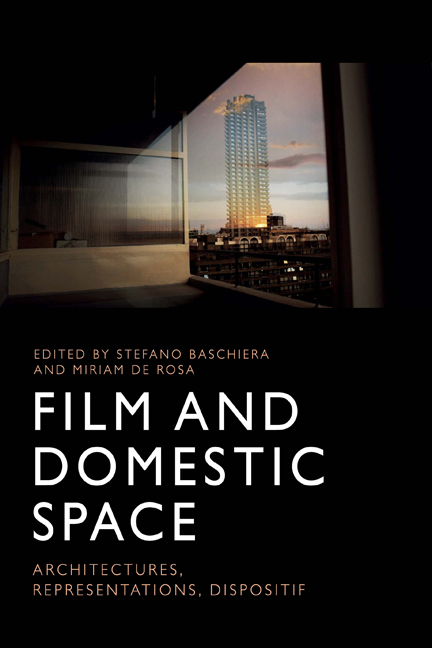Book contents
- Frontmatter
- Contents
- List of Figures
- Notes on the Contributors
- Acknowledgements
- Introduction
- 1 Architectures of Ubiquity: The Colonial Revival in Film and Television
- 2 No Down Payment: Whiteness, Japanese American Masculinity and Architectural Space in the Cinematic Suburbs
- 3 Resist, Redefine, Appropriate: Negotiating the Domestic Space in Contemporary Female Biopics
- 4 Liminal Spaces, Lesbian Desire and Veering off Course in Todd Haynes’s Carol
- 5 A Home on the Road in Claire Denis’s Vendredi soir
- 6 Acoustic Ectoplasm and the Loss of Home
- 7 Our House Now: Flat and Reversible Home Spaces in Post-war Film and Television
- 8 From Myth to Reality: Images of Domestic Space in Post-Soviet Baltic Films
- 9 No | Home | Movie: Essay Film, Architecture as Framing and the Non-house
- 10 At Home with the Nouvelle Vague: Apartment Plots and Domestic Urbanism in Godard’s Une femme est une femme and Varda’s Cléo de 5 à 7
- 11 Dwelling the Open: Amos Gitai and the Home of Cinema
- 12 What Is Cult When It’s At Home? Reframing Cult Cinema in Relation to Domestic Space
- 13 High-fructose Cinema and the Movie Industrial Complex: Radicalising the Technology of Representation in a Domestic Kind of Way
- Index
9 - No | Home | Movie: Essay Film, Architecture as Framing and the Non-house
Published online by Cambridge University Press: 22 September 2020
- Frontmatter
- Contents
- List of Figures
- Notes on the Contributors
- Acknowledgements
- Introduction
- 1 Architectures of Ubiquity: The Colonial Revival in Film and Television
- 2 No Down Payment: Whiteness, Japanese American Masculinity and Architectural Space in the Cinematic Suburbs
- 3 Resist, Redefine, Appropriate: Negotiating the Domestic Space in Contemporary Female Biopics
- 4 Liminal Spaces, Lesbian Desire and Veering off Course in Todd Haynes’s Carol
- 5 A Home on the Road in Claire Denis’s Vendredi soir
- 6 Acoustic Ectoplasm and the Loss of Home
- 7 Our House Now: Flat and Reversible Home Spaces in Post-war Film and Television
- 8 From Myth to Reality: Images of Domestic Space in Post-Soviet Baltic Films
- 9 No | Home | Movie: Essay Film, Architecture as Framing and the Non-house
- 10 At Home with the Nouvelle Vague: Apartment Plots and Domestic Urbanism in Godard’s Une femme est une femme and Varda’s Cléo de 5 à 7
- 11 Dwelling the Open: Amos Gitai and the Home of Cinema
- 12 What Is Cult When It’s At Home? Reframing Cult Cinema in Relation to Domestic Space
- 13 High-fructose Cinema and the Movie Industrial Complex: Radicalising the Technology of Representation in a Domestic Kind of Way
- Index
Summary
The House and the Real
Placing the accent on the pervasiveness of the migratory experience in our times, and on its production of a ubiquitous condition of homelessness, John Berger (1991) – drawing on Mircea Eliade – describes the original meaning of home as the ontological centre of the world, positioned at the heart of the real:
In traditional societies, everything that made sense of the world was real; the surrounding chaos existed and was threatening, but it was threatening because it was unreal. Without a home at the centre of the real, one was not only shelterless, but also lost in non-being, in unreality. Without a home everything was fragmentation. (56; emphasis in the original)
The home, for Berger, was at the centre of two ideal lines, one vertical, with the sky and the underworld at its two extremities, and one horizontal, representing ‘the traffic of the world, all the possible roads leading across the earth to other places’ (56). At the reassuring intersection of the two lines, the home was ‘nearest to the gods in the sky and the dead in the underworld [and] at the starting point and, hopefully, the returning point of all terrestrial journeys’ (56). The loss of the home that characterises emigration as the emblematic condition of our times, therefore, implies a profound deprivation of meaning for which one can go as far as ‘abandoning oneself to the unreal which is the absurd’ (56).
The home, in this conception, is what used to make sense of the world. For Berger, this ancient meaning of home having been lost, it has been replaced with that of the house as temporary shelter, in which habits involving gestures and objects strive to create a sense of protection. As Gaston Bachelard (1994) writes, whenever humans find the slightest shelter they make a home of it with their imagination, and can ‘build “walls” of impalpable shadows’, comforting themselves with the illusion and memory of protection (5). Yet, it is the unbridgeable gap between the values of the modern house and the ontological centredness of the traditional home, ‘the original fullness of the house's being’ (Bachelard 1994: 8), that I want to bear in mind as the backdrop of my discussion, which will deal with the real insofar as it concerns itself with nonfictional filmic houses – as distinct at once from constructed sets and from fictional homes.
- Type
- Chapter
- Information
- Film and Domestic SpaceArchitectures, Representations, Dispositif, pp. 154 - 170Publisher: Edinburgh University PressPrint publication year: 2020



